Market
Andy Warhol’s Computer Portrait of Debbie Harry Goes on Sale for a Cool $26 Million
The sale includes a Warhol-signed diskette containing 10 images the Pop artist created on an Amiga computer.
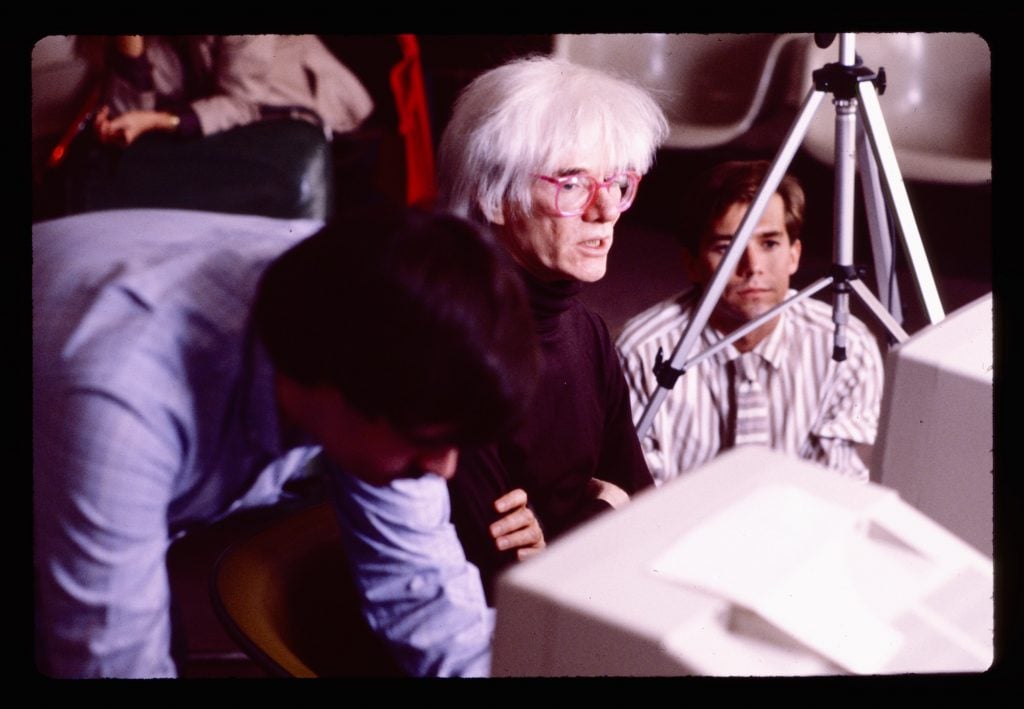
The sale includes a Warhol-signed diskette containing 10 images the Pop artist created on an Amiga computer.

Eileen Kinsella

A rare portrait of iconic Blondie lead singer Debbie Harry that was created via computer by Pop art star Andy Warhol in 1985, is being offered for sale by one of the computer engineers who had a hand in its making and was there the day that it was created.
The work doesn’t necessarily fit into the classic structure of Warhol’s prolific and legendary output—including 11 works sold at over $50 million each and a record auction price of $195 million, according to the Artnet Price Database. But this rare digital portrait and accompanying objects, including a Warhol-signed floppy disk with 10 images and other related ephemera, might just hit its $26 million opening asking price if the intriguing backstory appeals to the right deep-pocketed collector or museum.
The former Commodore engineer who worked with Warhol and owns the work is Delaware-based Jeff Bruette. After Warhol reached an agreement on a collaboration with Commodore Computers in June 1985, Bruette made several trips to the Factory, Warhol’s Manhattan studio, to train him on how to use both the computer and its graphics software.
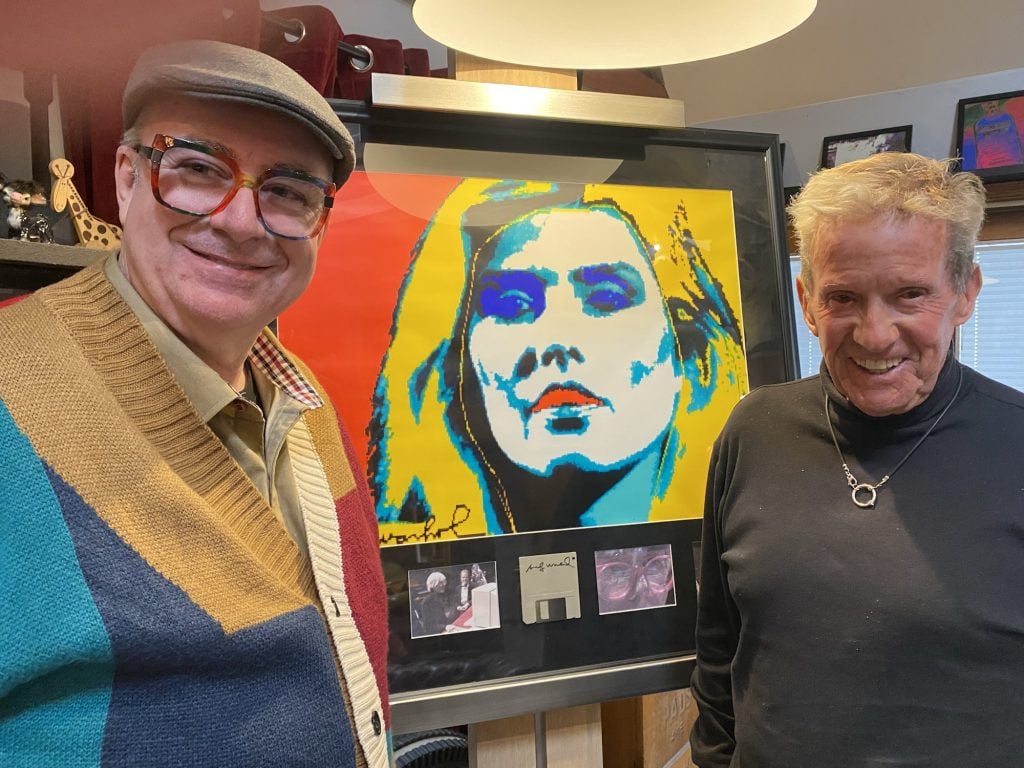
Former Commodore Amiga engineer Jeff Bruette (left) and sales agent Kenneth Mitchell (right). Photo courtesy Jeff Bruette.
“When I was initially sent to work with Andy from Commodore, I had no idea who he was… I mentioned to a co-worker that I had no idea why they hired a person with no computer experience, [and] he asked who it was,” Bruette told me over the phone.
His colleague told him who Warhol was, explaining that he was the artist behind the canvases depicting Campbell soup cans. “I was not familiar with that artwork at the time,” said Bruette, “and just assumed that Andy had designed the labels for the soup cans that sit on grocery store shelves.”
Bruette was on hand several weeks later for the day of the public launch at Lincoln Center where Warhol invited Blondie frontwoman Debbie Harry to model for a portrait. Following a morning rehearsal and press conference, Warhol went on to demonstrate his skill with the software by creating a now-famous portrait of Harry, a version of which the singer owns and wrote about in her 2019 memoir, Face It: Debbie Harry.
As part of the collaboration, Bruette explained, Warhol created additional digital images and sat down for an interview with the magazine Amiga World. “I was there to help Andy with the technical aspect of things during that interview,” Bruette said. “A number of images were created. Some appeared in the magazine at the time and one was used for the cover. I don’t have the cover images; I have the raw images and colorization that Andy did when trying to design what might be on the cover.”
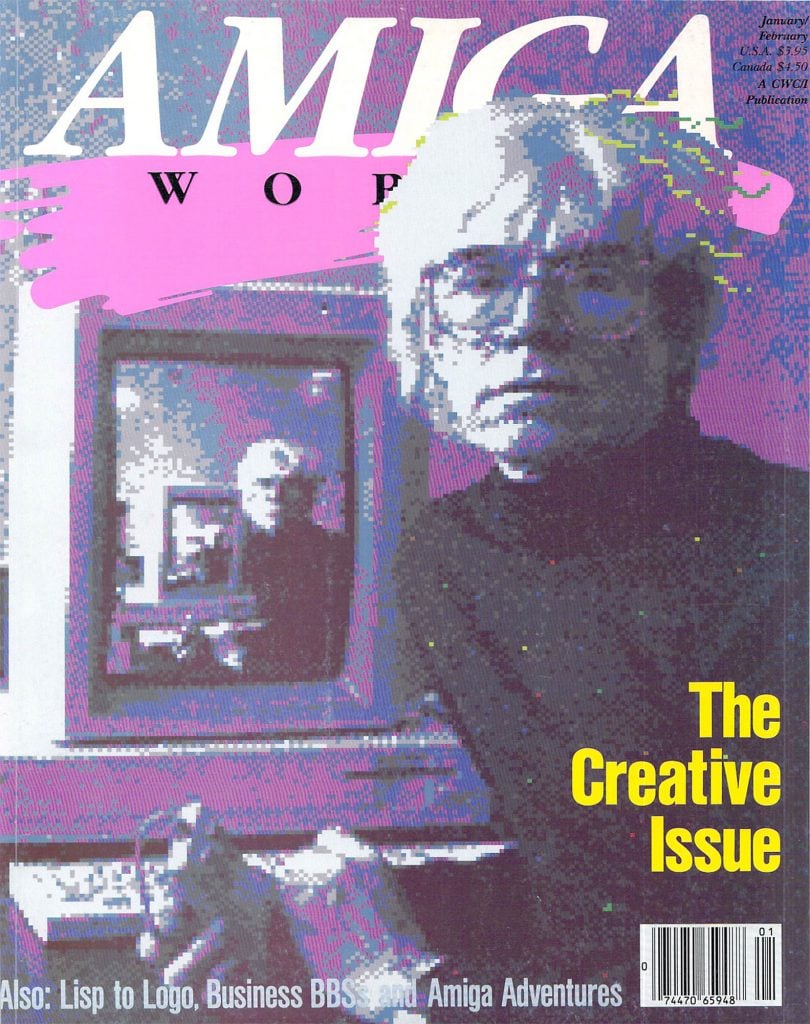
Warhol on the cover of Amiga World, 1985. Photo courtesy of Jeff Bruette.
At Bruette’s request, Warhol signed the diskette. Bruette said he actually offered it to Warhol but the artist insisted he keep it for himself. Further, in partnership with actor Bradford Louryk (who is in the process of producing a documentary on the history of Warhol’s digital works), Bruette has acquired roughly 150 photographs shot by Edward Judice on the day of the Amiga World interview.
He later obtained the print in the early 1990s, when Commodore was in dire financial straits and a fellow executive was packing up her office. Bruette asked what it was and she replied: “It’s a print from the Amiga launch. Do you want it?” He happily accepted the offer.
As part of the offering, the sale will also include: four photographs extracted from the Amiga launch event video; a second 3.5-inch diskette containing an additional eight digital image files created by Warhol during the Amiga World interview session; one digital image file created as a test for Warhol’s MTV series; a copy of the digital image file of the Debbie Harry portrait; a USB thumb drive containing backup copies of all digital image files; an Amiga 1000 computer system (main CPU unit, keyboard, mouse, and monitor) on which the original images may be viewed; and the sharing of all available press materials and media associated with the launch event in support of provenance.
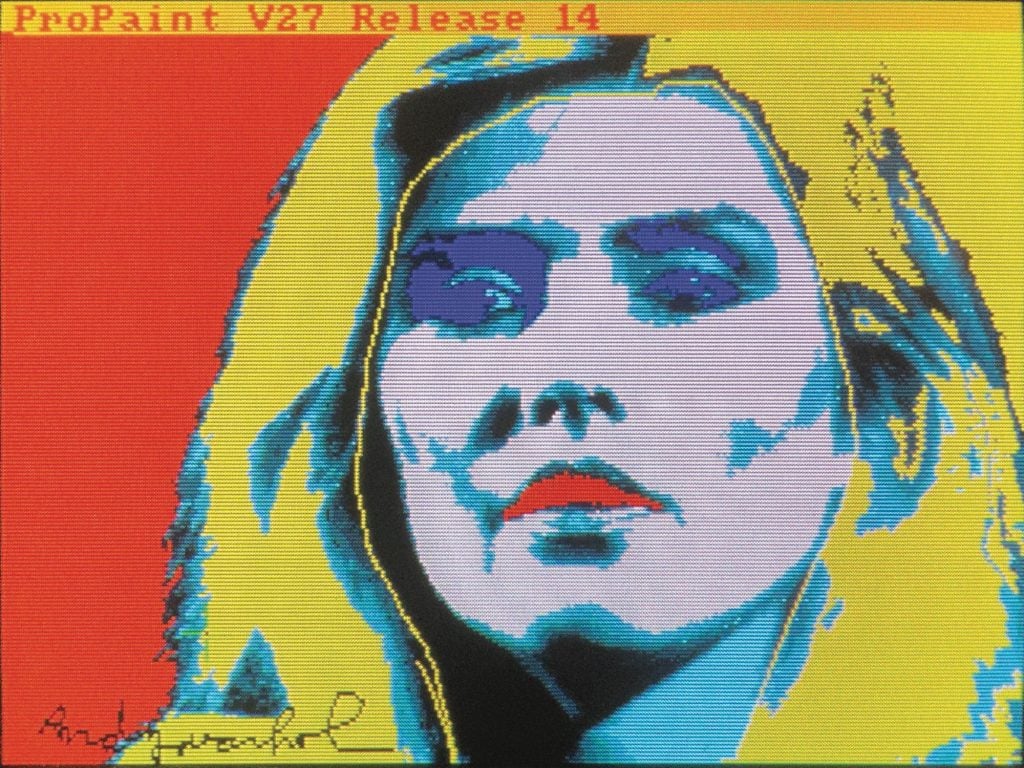
Andy Warhol portrait of Debbie Harry created with the Commodore Amiga computer in 1985. Photo courtesy Jeff Bruette.
“When I walked into [Jeff’s] house and saw the Debbie Harry print on the easel, I thought, ‘oh my god, this is the real McCoy’,” veteran art dealer Kenneth Mitchell told me over the phone from his home in Malibu. Mitchell formerly operated between New York and Palm Beach and was instrumental in gifting the major Warhol collection of Richard Holmes to Williams College before the collector’s death in 2008.
“I knew Andy personally and I knew this period of time. I went to the Factory several times,” said Mitchell. “After Andy did this demonstration at Lincoln Center, he fell in love with computer art. He was just mad for it. He said he could be Walt Disney, that he always wanted to be Walt Disney,” said Mitchell. Warhol even said he could do it faster, “and that if he made a mistake with the colors he could just go back,” and strip it out.
After a two-hour-plus meeting with Bruette in his home in rural Delaware, Mitchell said, “I checked things out extremely thoroughly for the next three weeks before we started negotiating on a contract.”
Mitchell acknowledged that the unusual nature of the material and the diskettes itself might be a little “tricky.” However, he thinks a number of museums may be interested: “I learned so much about how people love this type of thing. It’s a little tricky with the floppy disk, but that’s also what makes it purely authenticated. The provenance on it was there side-by-side with tons of photographs of [Bruette] showing [Warhol] how to work the computer. I don’t have an ounce of doubt that this is as pure as it can be and it’s in great condition.”
Richard Polsky, an author and Warhol expert, agreed. He told me: “These are unchartered waters in the Andy Warhol market. Since the image depicts Debbie Harry, it has a fair amount of value.”
The market for the artist’s Amiga-based works was somewhat tested in 2021, when the Andy Warhol Foundation sold five of his computer drawings as NFTs. The images, which include depictions of a banana and a Campbell’s soup can, sold for a collective $3.3 million at Christie’s.
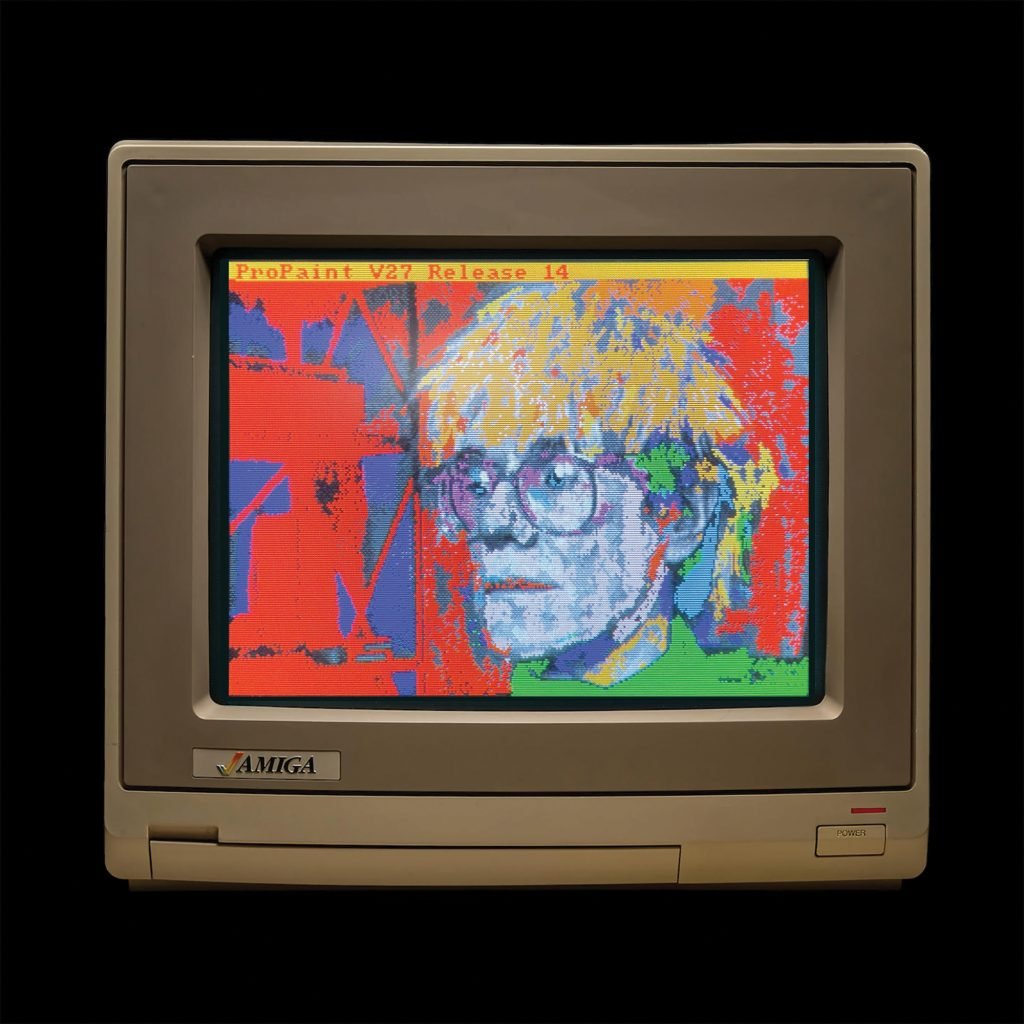
A self-portrait that Andy Warhol created in 1985 using the Commodore Amiga computer. Photo courtesy Jeff Bruette.
Around the time that he removed the Debbie Harry print from storage and framed it in 1999, Bruette approached the now-defunct Warhol authentication board about the diskette. He said he was informed that the board didn’t consider the signed diskette to be part of Warhol’s portfolio. According to him, he was told, “it was just an autographed item and that he autographed things all the time… you ought to just keep it for yourself as a nice memento.”
The authentication board dissolved in late 2011, after spending millions fighting legal claims, several brought by disgruntled owners of works that were rejected as inauthentic.
Bruette has had his own share of ups and downs over the years. After his work with Commodore, he went on to launch a successful business in Delaware titled Great Big Stuff that collected and sold oversized movie props. In 2013, he was hit with allegations of sexual abuse by a former employee. Criminal charges were eventually dropped by the state authorities.
Bruette left us with an additional colorful anecdote about the particulars of that now legendary day in Warhol’s career and in computer art history.
In the morning at the rehearsal, Warhol created the picture of Debbie Harry that Bruette saved to the diskette. At the actual event that night, where the lighting was different, “the image that he created at the actual event was unrecognizable,” said Bruette.
“So, the video that is floating around the world that shows Andy creating this picture of Debbie at the Amiga launch was actually edited to be that way because after the event, the technical person for marketing for Commodore,” realized it was a “horrible” image of Debbie.
“I went to Broadway Video in New York to put together the actual video that was going to be shared with dealers… so I had the diskette from the rehearsal and we edited in the image from the rehearsal which has become the image associated with the Amiga launch event now for 40 years.”